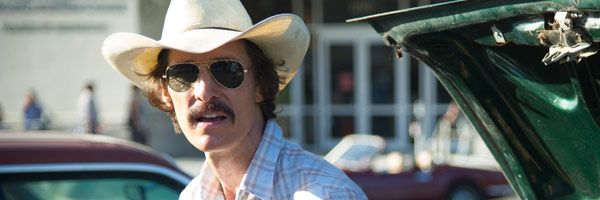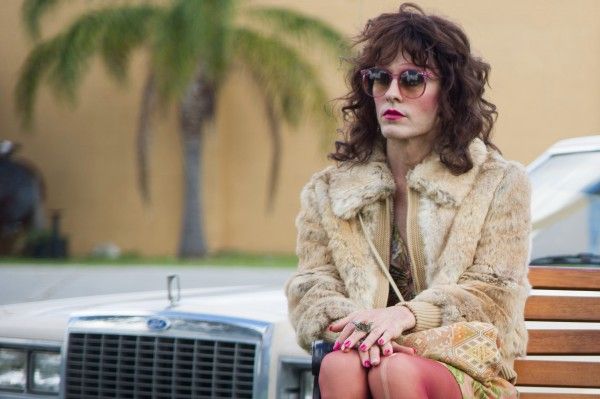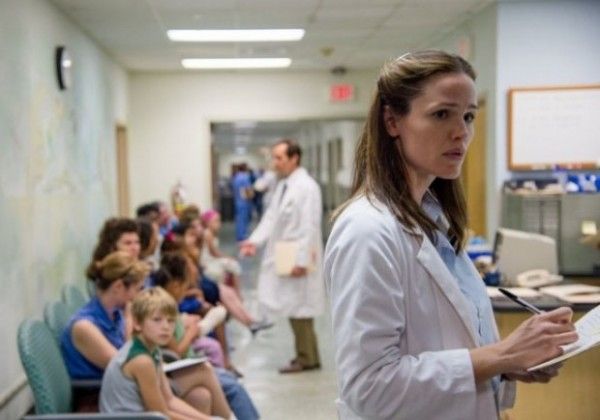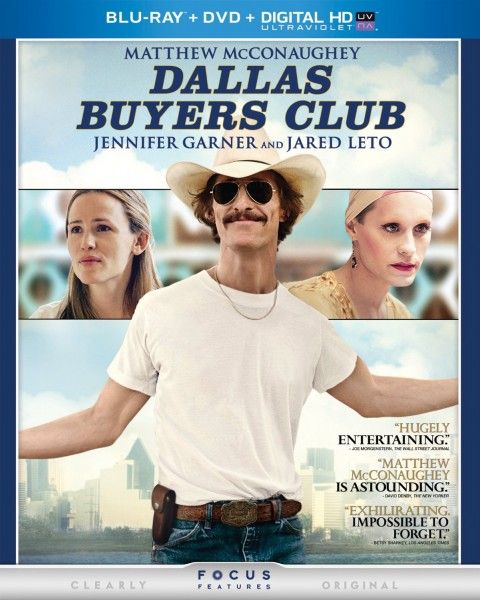Years from now, I suspect that critics will look back and declare the 2013-2014 film season as “The Year of the McConaughey.” After a decade of squandering his acting chops and Southern drawl in mediocre Kate Hudson rom-coms, McConaughey has had the ultimate breakout season, with Mud, HBO’s wildly popular True Detective, and his upcoming lead in Christopher Nolan’s highly anticipated Interstellar. Garnering rave reviews and earning him a Best Actor nomination, Dallas Buyers Club is yet another exceptional standout in McConaughey’s recent breakout. Hit the jump to read my Blu-ray review of the film.
McConaughey stars in Dallas Buyers Club as Ron Woodroof, a partying Texan who works at a rodeo, until a work-related accident renders him HIV positive. Having lost a staggering 40 lbs for the role, McConaughey is all but unrecognizable, save for his distinct Southern accent. Set in 1985, when the world was much more naïve to the causes and effects of the virus, Woodroof does not believe the diagnosis to be true, since he is not a homosexual. It takes him a fair amount of time to get over his initial denial and realize the gravity of his sickness when he is given approximately 30 days to live.
After bribing a hospital employee to give him AZT, the only FDA-approved HIV drug, Woodroof realizes that this drug is not helping him, but killing him. Taking matters into his own hands, he travels to Mexico, where a doctor gives him supplements like ddC and Peptide T to curb the sickness, neither of which are approved by the FDA in the United States. When Woodroof realizes that these drugs are effective, he begins to smuggle them into the United States. After forming an unlikely partnership with transvestite Rayon (played by an unrecognizable Jared Leto), they start the Dallas Buyers Club, where they sell the aforementioned supplements to people with HIV and AIDS, warning them of the dangers of AZT. Woodroof and Rayon are also quietly supported by a nurse from the local hospital (Jennifer Garner), who does not approve of the use of AZT to treat HIV patients.
Not only does Dallas Buyers Club depict one man’s relentless fight against AIDS, but it also shows a man who was brave enough to stand up to the corruption of the FDA, who were approving of a drug with known toxic effects for the sake of profit. Much of this film deals with that controversy, as the simple supplements that Ron sells in the Buyers Club did far more to prolong the lives of the sick than AZT, which had almost immediate detrimental effect. While it avoids simply being a corporate whistle-blowing film and focuses more on Woodroof as a character, the film does help raise awareness that sometimes, even our health administrations may not have all of our best intentions in mind. Dallas Buyers Club is rarely preachy, but it does serve as a sober call to awareness regarding decisions made by major health corporations and administrations.
One thing that I appreciated deeply about this film is that it was challenging for me to watch. It was hard for me to watch transvestite characters dying of AIDS. Dallas Buyers Club does a good job of showing you these groups who many of us may even unconsciously consider outcasts, and it forces you to watch their lives play out, some of which are tragic. This film was helpful, because it challenged me not to simply avoid what I don’t understand, but to learn and engage. As soon as other characters in the film find out Woodroof has HIV, they back away like they’ve seen a ghost. I understand the fear of contracting such a terrible disease, but Dallas Buyers Club helps the viewer to remove fears and judgments, and to see these people for who they really are instead: beloved, human beings. This is most potently illustrated in the scene where Woodroof takes Jennifer Garner’s character out on a date, saying that it makes him feel “like a normal human being again.”
The most powerful symbolism of this film was a scene near the end, when Woodroof is shown riding a bucking bronco. The comparison is almost instantly understandable. Both living with AIDS and the act of riding a bucking bronco are losing fights. No person can hold on forever. However, this scene poignantly depicts Woodroof’s fighting spirit, reflecting the fact that he was able to fight on and live another 7 years after being originally diagnosed with HIV. It’s an evocative image. Dallas Buyers Club lives up to its critical hype. It is a film that is difficult to watch at times, but it is an unapologetic and inspiring depiction of a man who fought to stay alive, help others, and fight against an administration that wouldn’t do the same. Hats off to Mr. Woodroof. And sorry, Leo DiCaprio, but I hope that McConaughey wins the Oscar for this performance.
The Blu-ray copy of this film is shot in anamorphic widescreen (2.40:1), and it includes a DVD copy, as well as a Digital HD download to stream the film through Itunes and Ultra Violet. The picture is crisp, and it transfers nicely. Honestly, there is not much else to recommend about the Blu-ray copy specifically. The only Bonus Features offered are Deleted Scenes, of which there are only three, and a small featurette titled “A Look Inside Dallas Buyers Club.” Although this featurette has a few good insights from McConaughey, Leto, and Garner, it’s extremely short. Aside from the quality of the picture, I wouldn’t say there are many special benefits to the Blu-ray copy of this film.





